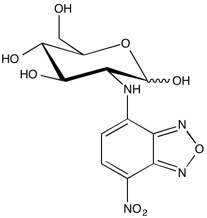2-NBDG | Glucose uptake probe
NMR (Conforms)

Available Options
| size : | Price | Quantity | |
|---|---|---|---|
| 1 mg | $42.00 | ||
| 5 mg | $168.00 |
2-NBDG (186689-07-6) is a fluorescent glucose uptake probe. May be used to monitor glucose uptake in live cells and as a cell viability indicator.1,2 Has been used to measure glucose uptake in cultured hippocampal astrocytes using confocal epifluorescence microscopy.3 NBD fluorescence typically displays excitation/emission maxima of 465/540 nm. Cell permeable.
References/Citations:
1) Yoshioka et al. (1996), A novel fluorescent derivative of glucose applicable to the assessment of glucose uptake activity of Escherichia coli; Biochim. Biophys. Acta, 1289 5
2) Yamada et al. (2000), Measurement of glucose uptake and intracellular calcium concentration in single, living, pancreatic beta-cells; J. Biol. Chem., 275 22278
3) Loaiza et al. (2003), Glutamate triggers rapid glucose transport stimulation in astrocytes as evidenced by real-time confocal microscopy; J. Neurosci., 23 7337
NMR (Conforms)
Safety Data Sheet:
Product Data Sheet:
Materials provided by Focus Biomolecules are for laboratory research use only and are not intended for human or veterinary applications. Please note that we do not sell to individuals and that all orders placed by non-research organizations will incur a $20 restocking/refund fee
2-NBDG (186689-07-6) is a fluorescent glucose uptake probe. May be used to monitor glucose uptake in live cells and as a cell viability indicator.1,2 Has been used to measure glucose uptake in cultured hippocampal astrocytes using confocal epifluorescence microscopy.3 NBD fluorescence typically displays excitation/emission maxima of 465/540 nm. Cell permeable.
References/Citations:
1) Yoshioka et al. (1996), A novel fluorescent derivative of glucose applicable to the assessment of glucose uptake activity of Escherichia coli; Biochim. Biophys. Acta, 1289 5
2) Yamada et al. (2000), Measurement of glucose uptake and intracellular calcium concentration in single, living, pancreatic beta-cells; J. Biol. Chem., 275 22278
3) Loaiza et al. (2003), Glutamate triggers rapid glucose transport stimulation in astrocytes as evidenced by real-time confocal microscopy; J. Neurosci., 23 7337
Calculate the molar concentration, mass or volume in a solution.
Concentration × Volume × Molecular Weight = Mass
Focus Biomolecules • Plymouth Meeting, PA USA • 1-855-FOCUS21
Focus Biomolecules
Plymouth Meeting, PA USA
1-855-FOCUS21
Website Created by Advanta Advertising LLC.

